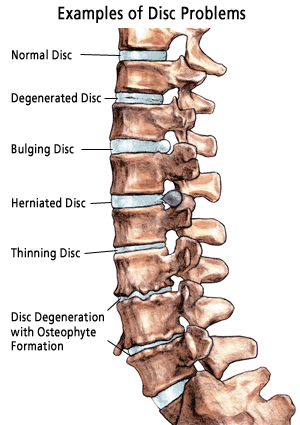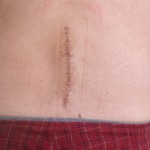I have chronic low back soreness in spite of having two neurosurgical operations over the fourteen years that we've been in Colorado. So I was excited to see a Medscape article, dated April 15, 2013, on a promising new treatment, one that clearly needs a prospective controlled trail, but a concept that offered me some hope.
My last post went over the anatomy of the spine, both the bony part, the spinal column & the nerve part, the spinal cord, cauda equine and nerve roots. Now I'd like to focus on low back pain (LBP), while acknowledging that many of us (including both my wife and myself) have problems with the upper spine, AKA the cervical spine.
The most frequent problem seems to be that strange entity called degenerative disc disease (DDD). When I've looked at a variety of sources on this condition, the feature that many of us with DDD have in common, is age. The Cedars-Sinai webpage on DDD mentions a critical point: as we age nearly all of us will show at least a modicum of signs of waer and tear on our final discs, yet many will have no symptoms. So the term, DDD, conventionally is used to refer to those who have pain from their damaged discs.
I copied the illustration below from the webpage of Dr. Jeffrey Goldstein, a New York City orthopedic surgeon and back specialist. He emphasizes that disc degeneration is a normal part of aging, but it can cause damage to nerves or cause pain by bones rubbing on each other.

As I mentioned briefly in my previous post, spinal discs are rubbery, so they can act like shock absorbers for the vertebrae. They also help the facet joints in allowing us to twist and turn; at the same time they are exposed to and resist tremendous forces. They have a tough outer layer and an elastic (more fluid) core.
They have minimal blood supply, so if they get damaged there's no repair mechanism built in. Then, much as my medical history reveals, over a considerable period of time, the injured disk causes acute pain limiting back movement, then pain may occur off and on as the bone that was injured loses some of its stability and eventually the portion of the spine injured restabilizes and pain occurs less frequently.
By the time we are sixty, partially depending on our sports and daily motion, we're quite likely to have disc degeneration, but, as noted above, we may or may not have back pain.
Sometimes, under various stresses, a disc pushes right through its outer membrane. We call this a ruptured or herniated disc. Roughly 90% of the time, if a disc herniation happens, it's in the low back. And most of those who rupture a disc are age 30 to 50. As we age beyond 50, our discs dry out and are less likely to rupture.
On the other hand, we can develop arthritic changes in the vertebrae (see illustration above) that cause pain by pressing on nerve roots leaving the spinal column. This is termed spinal osteoarthritis and, although it may occur in the younger set because of trauma/injury (under age 45 this is more common in men), it's typically seen and is more common in women over that age. There may be neck or back stiffness or pain, often lessened by lying down. It's even more frequent in those who have excess poundage.
Facet joint disease is another form of this osteoarthritis (the term osteo refers to bone). It may be associated with inflammation of the facets and cause the back muscle to spasm with increased pain on any motion of the area.
Sometimes the space in which the spinal cord lies gets narrowed; this is called spinal stenosis and occurs mostly in the neck or low back regions. It may be a congenital condition (one you are born with), but much more commonly is caused by overgrowth of bone, a ruptured disc, tightening of the ligaments that help keep your vertebrae together or even by injuries or a tumor. It's more commonly seen in those of us over 50 and, if severe can lead to complications (numbness, weakness, incontinence or even paralysis)
When I had an MRI and saw my neurosurgeon for the first time, I had all three conditions: a ruptured disc, facet disease and spinal stenosis.
I was fortunate in that, under light anesthesia, the surgical team did tests to determine exactly what levels of my spine needed fixing. Now I'm by no means a neurosurgeon or orthopedic back surgeon (My initial residency was in Internal Medicine), so I can't tell you exactly what my doc did.
But as best I know, he poked in a protruding disc, reamed out a facet joint opening and expanded whatever was causing my spinal stenosis.
That led to considerable improvement of my symptoms and signs (back pain and leg numbness and weakness with some shrinkage of the muscle above and to the inside side of my right knee) But some of the symptoms came back after six years and I had a second operation.
Now all I have is fairly regular low-grade back soreness; I'd sure like to get rid of that too. So when I found that article online in medscape.com, with the title "Autologous Bone Marrow Grafts Promising for Low Back Pain," I read it quite carefully.
It clearly is research at this stage and, as I mentioned, needs a large, prospective controlled trial, but researchers from Missouri reported a series of 24 consecutive patients (averaging 45 years old and with 17 men and 7 women) who had chronic LBP unresponsive to a number of therapy trials and all having lumbar disc disease. They took some of their own (AKA autologous) bone marrow from a hip, concentrated it and injected some into the lumbar disc affected and more just outside those discs.
This only took a short time (20 to 60 minutes) and most of the patients had considerable pain relief that lasted over a two-year followup period.
I'm eager to see more data on this new modality for treating chronic LBP.
Tags: autologous bone marrow graft, back surgery, disc disease, facet narrowing, low back pain, spinal stenosis

